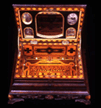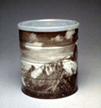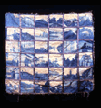

 |
 |

 |
 |
 |


 |
 |

 |
 |
 |
|
Organized by the Art Gallery of Ontario September 19 through November 14 In early photography, portraiture, which provoked apprehension as well as enchantment, was the genre of choice, and the public marveled at photography's startling verisimilitude. As enterprising photographers sought attractive applications for this new medium, the portrait morphed into the 3-dimensional object festooned with an image. There is a beautiful ruby glass perfume bottle with a daguerreotype inset in the lid, a 14k gold broach containing an ambrotype of a loved one, and walking sticks, tabletop clocks, writing instruments, and other luxury goods associated with le haute bourgeoisie. Before long photographs appeared on quilts, mirrors, clothing, furniture, souvenirs, and countless other quotidian items utilized by the middle and working classes. Curator Daile Kaplan has coined the term "Pop Photographica" for this hybrid form that defies simply categorization. An equal-opportunity art form, pop photographica necessarily subverts the conventional masterwork theory of art paradigm. Most of the imaginative creators of these quirky historical objects are inspired, but unknown. The range of items unabashedly links popular culture and photography, typifying the collapse of high- and lowbrow, art and commerce. Pop photographica dramatizes its subject (who are frequently unidentified), centralizes the function of the photograph (which provides a context for the object), and imparts irony to the role of the photographer (who is typically anonymous). It also discards a core component of photographic display, namely the picture frame. Pop photographica may be seen in the home, including women's domestic arts (sewing and embroidery) and tabletop furniture and altars; on the body, such as clothing, jewelry, hats, and handbags; and in the business environment, particularly promotion and advertising. It encompasses three primary categories: 1) handmade one-of-a-kind objects, which were initially upmarket and associated with an artisanal culture; 2) Art and Crafts aesthetic customized items, which were targeted to a burgeoning middle class, and first emerged in the 1850s, but are especially prevalent in the new economy due to the widespread use of digital technologies on a variety of substrates-polyester, cotton, leather, celluloid, chintz, silver and gold; and 3) pre-made or mass-manufactured objects, such as 19th-century souvenirs, playing cards, and jewelry, and in advertisements, which emerged full force in the early 20th-century. |
 |
 |
 |